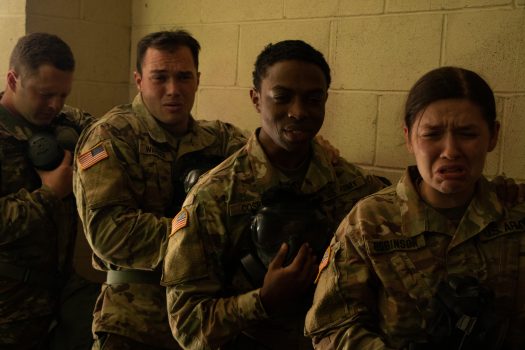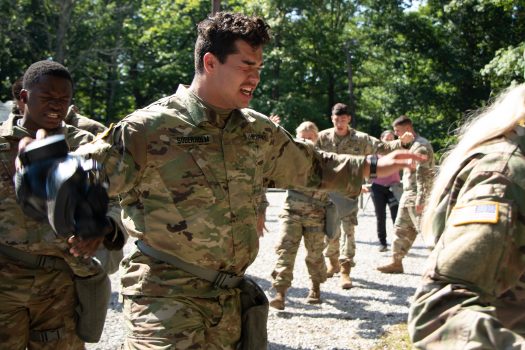Everyone has different threshold levels and in the case of the Chemical, Biological, Radiological and Nuclear (CBRNE) training event, it is all about who can keep calm and carry on.
“You have to stay calm. If you panic and your heart starts racing, you tend to breathe faster and that gets more gas inside,” said Cadet Aboujihad Dhimine, a student at Virginia Commonwealth University, originally from Morocco, who has five years of prior service as a bridge crew member. “So, I would say just stay calm and follow the instructions of the instructors inside and you’ll be fine. It goes away.”

For Dhimine, it was not his first time in the chamber and neither was it for Cadet Maame Ampofo, a student at West Chester University from Bucks County, Pa. who also has prior service as a petroleum supply specialist.
“It burns,” said Ampofo. “It feels like cooking peppers and onions and a whole bunch of spices and stuff, like spicy siracha basically.”
Even for Cadets who have encountered this type of training before it is always different.
“This one we stayed in it the longest than the previous two that I have done before,” said Dhimine. “But it was fun, the part when singing the songs, I have never done that before.”
There are some Cadets that are experienced, yet there are still a vast majority of Cadets who have never done this kind of situational training before who were looking forward to the CS (2-chlorobenzylidene malononitrile) chamber.
“I’m pretty excited. I mean, I’m pretty congested right now, so I’m looking forward to clearing out the tubes,” said Cadet Bryan Fu, a student at the University of Florida from Orlando, Fla.

Staff Sgt. Paville Simpson, the non-commissioned officer for CS chamber from the 172nd CBRNE Company Hazard Response, 2nd CBRNE battalion, Fort Riley, Ks., said the chamber might feel overwhelming to cadets, but when they step outside in the fresh air they will feel better.
“There’s a tightness. There’s a burn, but there’s nothing to be overdramatic about and to feel like you’re dying, you’re not dying— you can still breathe,” said Simpson.
This training can be fun and exciting, but there are still things Cadets have to learn prior to going into the CS Chamber. Simpson gave a brief introduction to what Cadets will be taught before the entering the chamber.
“We are here to basically train you, so you know what CS gas feels like so when you come into contact with a CBRNE agent you know how to properly don your mask, don your JSLIST (Joint Service Lightweight Integrated Suit Technology) and what to do from there when responding to chemical weapons,” said Simpson.




